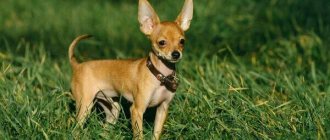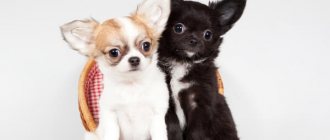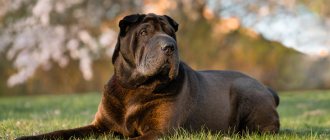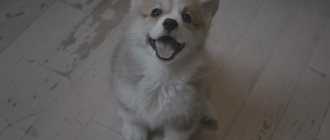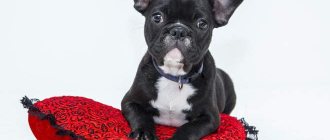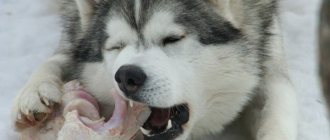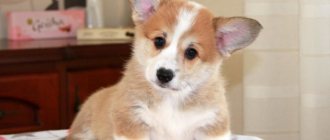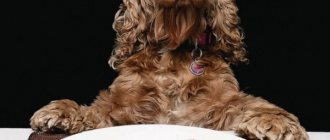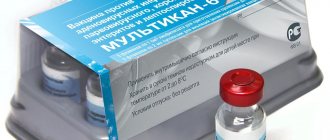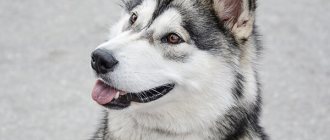Toy terriers are miniature dogs that look like puppies until they are old.
Like all purebred dogs, they have a standard weight and height.
The puppy's development must be monitored.
Since too small sizes can become a dangerous deviation - female toy terriers will not be able to bear offspring.
Difficulties in selecting drug dosages complicate treatment.
Find out about the norms of basic parameters in this article.
Adult pet weight
An adult dog weighs about 3 kg .
Sometimes there are mini toys weighing 0.9-1 kg. This weight is considered normal for a boy.
But if you are going to breed puppies, the Toya girl must weigh more than 1.8 kg for gestation and birth without complications.
More often 1-3 puppies are born . Their weight is 70-170 grams, which is a lot for such a small dog.
Puppy weight and height by month
The table is indicative. A discrepancy of ±300-400 g is possible. It is worth examining the dog if the weight differs from the table by 1 kg.
Puppies grow disproportionately: in one month they gain a lot, and in the next month the weight will not change . Focus on the condition of the toy. If he is active, playful and eats well, then everything is fine.
The conventional concept of norm also applies to growth.
Puppies are sold at approximately 3 months . At this moment their height is 15-20 centimeters.
The standard toy will grow even bigger by 6-9 months, but the mini toy will no longer be there.
Weight table:
Growth chart:
Caring for the Russian Toy
Dogs of this breed are unpretentious in maintenance. These are not the big dogs that need to be walked several times a day. The toy is great at learning to go to a regular cat litter box when needed. However, walking cannot be completely ruled out. A small terrier needs periodic outings into nature and fresh air for its psychophysical health.
This dog does not require frequent bathing, only once a month. During water procedures, it is worth inserting cotton wool into your ears to prevent water from flowing into them. In addition, your ears should be checked for infections from time to time. Also, as necessary, the toy's claws are trimmed.
Caring for the coat of the long-haired variety comes down to daily combing with a fine-toothed comb - a pleasant procedure for both the pet and its owner. Although a terrier is considered a tame dog, you shouldn’t carry it in your arms or in a bag all the time, it needs a burst of bursting energy.
Nutrition
The diet of a toy terrier must be balanced and contain the necessary vitamins and microelements. Products that can be given to your Russian Toy:
- meat, 50-60 g per day - lamb, beef, beef by-products, chicken;
- lean fish, 1 yolk (no more than once a week);
- fresh vegetables: cucumbers, zucchini, carrots, cabbage, peppers, beets;
- porridge: buckwheat, rice;
- fermented milk products: fermented baked milk, kefir cottage cheese;
- fruits: apples, pears, bananas, peaches, apricots.
With natural nutrition, it is necessary to supplement your pet’s food with vitamins and microelements. You can make a table of the required additives in advance.
Pet stores offer a wide range of concentrated dry food and canned food for dogs. For a small pet, choose a product that is appropriate for its weight and age.
Good nutrition is the key to a toy terrier’s well-being.
Mini toy terrier
There is no separate standard for this breed . Mini toy terriers are usually classified as dogs whose sizes are smaller than standard ones.
The weight of an adult dog is less than 1.5 kg, the height at the withers is about 20 cm.
Mini Toy Terrier females are not allowed to give birth.
The mini toy is no different in character from the standard one. But it requires a more careful attitude. They break limbs much more often, and if they play carelessly, they can twist their jaw.
There are advertisements for the sale of super mini toy terriers . The weight of such dogs is up to 1.3 kg.
approximate cost
To purchase an animal, you can contact a toy terrier nursery. The range in prices for these dogs is great. Females are much more expensive than males.
Data on how much the average puppy will cost is shown in the table below.
Dynamics of prices for toy terrier puppies (thousand rubles).
| Find out if your toy has gotten fat? Toy Terrier and its weight - This is a rather important topic that is worth paying attention to. To be aware of whether your toy is developing correctly and whether he is healthy, you need to know exactly How much does it weigh mini, puppy and adult toy terrier, as well as how much it should weigh according to the weight chart. Of course, the height and weight of one toy terrier may differ significantly from the parameters of another representative of the same breed due to many circumstances, but despite this, there is a concept of normal dog weight. For example, the weight of a 3-month-old toy terrier should differ from the size of a two-month-old puppy, which, however, should be clear to every sane person. | |||||
| Normal size | Mini puppies | ||||
| Quality | Cable | Female | Cable | Female | |
| "Pat" | From 10 to 13 | From 15 to 18 | From 12 to 18 | From 15 to 20 | |
| "Brid" | From 18 to 25 | From 25 to 35 | From 25 to 35 | From 27 to 35 | |
| "Show" | From 40 to 70 | From 40 to 90 | From 40 to 90 | From 40 to 90 | |
The high cost is explained by the large monetary and time costs of breeders.
Breeding purebred puppies requires considerable investment:
- veterinarian services;
- time to study and communicate with kids;
- healthy diet;
- vaccinations;
- medications that protect against parasites;
- bowls and dog toys, etc.
When purchasing a toy terrier, be prepared to become his real parents.
Story
From time immemorial, in Russia, as in Europe, noble ladies were fond of small dogs. They cared for, cherished their pets, immortalized them in portraits. Mostly animals were brought from abroad. The most common breed was the English Toy Terrier.
After the October Revolution, when there was no aristocracy left in Russia, no attention was paid to these individuals and breeding of toy terriers ceased. These dogs were on the verge of extinction.
In the middle of the last century, interest in the toy terrier breed was restored in the country. The Iron Curtain prevented the bringing of new animals to the USSR. Cynologists tried to restore the population of these dogs and as a result developed a modern species. After crossing two smooth-haired sires, one puppy with fringed ears appeared. It was decided to consolidate this feature and give the breed a name - Moscow Toy Terrier.
The result of the experiment turned out great. Now the dog looks decent at exhibitions and competitions.
When is a dog considered an adult?
Decorative breeds develop faster than others.
A dog is considered an adult when its period of physical development ceases.
This usually occurs at 6-9 months in a standard breed, 4-5 in a mini toy terrier..
Mental development ends at 4-5 months. Therefore, puppies are trained from a very early age.
Signs of an adult dog:
- eyes are clean, clear, without clouding;
- baby teeth were replaced by permanent ones;
- the dog’s body is toned, strong, proportional; height does not change, but weight may increase.
How long do mini toy terriers grow?
Mini Toy Terriers are a variation of the standard breed. These are real “pocket” dogs, fragile and miniature. Due to their special body structure, their development is slightly different from that of ordinary toys. But for mini-toy terriers there is no separate standard for appearance and weight; it is assessed according to the standard of a regular terrier. Therefore, it is necessary to study their characteristics based on the experience of breeders.
Mini Toy Terrier even fits in a tea cup
Miniature toy terriers grow up to 4-5 months, while the level of development is the same as that of the standard breed. These babies can grow to a maximum of 23 cm and weigh up to 1.8 kg. If, after reaching this indicator, the puppy continues to grow, it means that the breeder decided to make extra money when selling and passed off the standard terrier as a mini-breed. In appearance, these two varieties differ only in growth, but the final result can only be determined after six months.
Important! Mini Toy Terriers are even more fragile than standard ones. They are small enough to fit into a cup. If an ordinary terrier can break a paw by jumping off the sofa, then a mini's fragile limb can be damaged even if it runs very actively on the floor.
Choosing a baby
To choose your future pet, follow these recommendations:
Pay attention to the habits, character, and appearance of the kitten. The eyes, nose and ears should be clean. Any discharge indicates poor health.
The coat should be shiny and smooth. In the anal area there are no signs of loose stool.
Call them, the first one to respond will be the kindest. Loyalty is unlikely to be his trait; rather, an affectionate attitude will be manifested on his part towards everyone around him.
Consider deviations from developmental standards (weight, height, color). This is how much a kitten should weigh approximately:
| Age | Weight |
| 1 month | 200–650 gr. |
| 2 months | 320–1050 gr. |
| 3 months | 460–1550 gr. |
| 4 months | 600–900 gr. |
| 5 months | 700–2200 gr. |
| 6 months | 800–2500 gr. |
When purchasing a pet for exhibition purposes, you should immediately pay attention to all the subtleties required for toy terriers.
Check out the documentation and pedigree. And also specify how many times vaccination was carried out.
Parameters of an adult toy terrier
Boys and girls of toy terriers are almost no different from each other in appearance. In some breeds, boys are more impressive and larger, but toys do not have this feature.
The height of an adult animal is up to 28 cm, anything higher does not fit into the breed standard:
According to the format, terriers are square.
For this format, the following characteristics apply::
- The oblique length of the body is equal to the height at the withers. Oblique length - from the extreme point of the chest to the sit bones. Height at the withers - from the ground to the withers.
- The back-lumbar-croup ratio is 2:1:1. If we conditionally divide the length of the dog (from the base of the neck to the beginning of the tail) in half, then the part at the neck is the back. Then comes the loin, followed by the croup.
- The height of the limbs is slightly more than half the height at the withers.
Appearance
The rounded head of the toy terrier is small. The transition from the animal's forehead to the pointed muzzle is clearly noticeable. The dog's thin lips fit tightly and cover his white teeth. The breed standard describes the animal's bite as a scissor bite, with the upper canines slightly covering the lower ones.
The small nose of the toy terrier is painted black or to match the “fur coat”. The dog's small ears stand high. The eyes of the representative of the breed are quite large compared to the size of the head. They are placed widely and appear convex. Dark eyes are tightly covered with eyelids, the color of which matches the color of the dog’s fur.
The Toy Terrier's neck is long and slightly curved. The dog's body is compact and well built with a flat back and slightly rounded croup. The animal's tail points upward. It is customary to dock the tail. The standard allows undocked ponytails shaped like the letter “C”.
The toy's chest is round and of medium width. The abdomen is well tucked, without sagging. The dog's legs, in comparison with the body, seem quite long. They are straight and parallel to each other, with the rear ones being slightly wider than the front ones. The animal's paws are small, rounded and tightly packed.
Description of the breed
The Toy Terrier is an ornamental dog that prefers to live in comfortable conditions, sometimes even without regular walks: they cannot be kept on the street. Although Toy Terriers themselves imagine themselves to be large guard dogs, in reality they are fragile and defenseless. It is not for nothing that the name of the breed is translated from English as “toy”.
The name of the breed is translated from English as “toy”
Body shape, appearance
This is a relatively young breed that was bred in Russia. She was not known for a long time, but in the 21st century there was some kind of explosion of popularity. Everyone started buying Toy Terriers - from breeders to housewives.
The breed standard describes the Toy Terrier as follows:
- the body is square, with a fragile skeletal system, angular muscles;
- not pronounced rounded knees;
- head in the shape of an inverted triangle, rounded skull, large protruding forehead;
- dark eyes slightly bulging;
- pointed muzzle, sharp large ears, set high;
- the tail is long, docked from the second vertebra.
The baby is very nimble and is popular in families with children, as he agrees with them in his desire to play. The average height of a dog at the withers is 20-25 cm. Excellent for breeding in an apartment or private house. Toy terriers live for about 12-15 years, but life expectancy still depends on the care, care and attitude of the owner.
The Toy Terrier feels great in a person's home
Important! You should not adjust your pet to these standards if it will not participate in dog shows or shows.
Wool
Based on coat type, Toy Terriers are divided into two groups:
- Smooth-haired. They resemble a small deer due to their smooth shiny fur and protruding, almost doe-like eyes. The short coat lies close to the body.
- Long-haired. The body is covered with hair up to 5 cm long, which can be smooth or slightly wavy. There is an elegant fringe on the ears, and the fur on the paws completely covers the claws. A special article dedicated to this type of dog has been published on our portal
These varieties do not differ in height and weight. Active babies do not have a strong odor, and their fur does not cause allergies.
Smooth-haired toy terriers
Longhaired Toy Terriers
Color
Some breeders are baffled by the coloring of the toy terrier. Dark coat colors are common, but in reality the Toy can be any color. The following shades are available:
- black and tan;
- brown;
- red of various tones;
- gray-blue (the most fashionable shade);
- lilac, isabella color (experimental shades).
Sometimes puppies of unusual colors are born from crossbreeding. For example, there is a known case when a female fawn toy terrier gave birth to a lilac baby from a long-haired red male. Breeders are increasingly trying to breed dogs of rare and fashionable colors. Although the result is excellent, veterinarians do not advise engaging in such experiments. Such puppies may not live up to 5 years.
Toy terrier puppy of rare isabella color
Character and intelligence
Toy terriers are active, agile and hardy. They are very loyal, becoming attached to only one person, whom they consider the owner. They treat other family members calmly. The puppy is sociable and playful, loves to spend time with children.
Character Traits:
- friendly. He is friends with all family members, guests, and other dogs. Feels great around pets of other breeds, but sometimes can rush even at a large dog if it senses a danger to the owner;
- trainable. Terriers have a very high level of intelligence and can easily remember commands. Even in stressful situations, they are able to soberly assess the situation and make correct decisions;
Interested toy terrier
- babies have an amazing memory: they can remember the owner, even if they haven’t seen him for 5 years;
- cunning. As your pet gets older, its cunning becomes more and more evident. The main goal for a toy terrier is to search for the owner’s weak points, so that he can then easily manipulate him;
- loves to travel. He is ready to go with his owner anywhere - to the store, on a hike, for a walk in the park. Fortunately, the small size of the dog will not burden the owner on the road;
The Toy Terrier is always ready to travel with its owner
- cannot stand loneliness. The Toy Terrier cannot be left unattended: it becomes nervous, angry, and attacks people. Those who cannot spend enough time with their toy because of work should not get this breed or should consider buying two dogs at once so that they do not get bored.
Despite the miniature and sociability, in general the character of the toy terrier is very serious. Inside the family, the dog will behave peacefully towards all family members, but outside it it will protect the owner from any encroachment.
Important! Some owners are confused by the fact that the pet periodically begins to shake while sitting in their arms. This is due to an excess of emotions and energy due to a pronounced temperament. To channel this energy in the right direction, Toy Terriers need to be trained.
Video - Teaching a toy terrier commands
Factors influencing performance
Growth and development depend on proper nutrition. The diet should contain minerals and vitamins, especially calcium, and healthy fats.
Decide on the type of food - natural or food. Mixed nutrition is undesirable.
It is better to feed your puppy on a schedule:
- 1.5 – 3 months: 4 times a day;
- 2 – 4 months: 3 times a day;
- 4 – 6 months: 2 times a day.
Serving size for 3-4 meals a day is about 30 g. You cannot overfeed, otherwise excess weight will form.
Calcium and phosphorus are essential for strong bones and teeth . A calcium deficiency is indicated by the toy's ears. If they first rose and then hung, the puppy needs vitamins. Multivitamins should be introduced into the diet gradually, monitoring the pet’s health.
The puppy is taken for vaccination. The first vaccination is given at approximately 6 weeks .
This prepares the body for the next dose. The next vaccination is given at 2.5 months, it will protect the body from diseases - distemper, hepatitis, etc. If the puppy suffers some kind of disease, the consequences are irreversible.
At what age is the tail docked?
Dog experts agree that the best time to dock a tail is at birth.
A newly born puppy does not feel pain , so the procedure is much easier. If for some reason docking was not performed during this period, then the procedure should be carried out by a veterinarian. The appropriate age for a completely healthy puppy is 3-4 days after birth.
If the puppy does not participate in exhibitions, then such a procedure is not necessary at all.
Lack of weight: what to do?
Being underweight is no less dangerous than being overweight. Check the puppy weight chart by month.
If the ribs and spine of the toy terrier are noticeable even without palpation, then the dog is unhealthy thin.
If the puppy has stopped gaining weight, it is recommended:
- Give the puppy anti-helminth medications. When parasites are inside an animal, they prevent nutrients from being absorbed and suck them out themselves.
- Try giving your puppy more exercise. Play with him more often, take him for a walk.
- Increase the portion. Or increase the number of meals.
- Read the composition of the food. Meat ingredients should come first, not cereals. Buy food from the premium segment, marked “for puppies”.
- Contact your veterinarian. Weight loss is a symptom of diseases, such as hepatitis, cancer or inflammatory processes in organs.
Overweight dog
Deviations from the table indicators in a larger direction can indicate both individual characteristics, for example, the size and height of a terrier are slightly larger than average, and the presence of obesity in the pet.
In addition to large mass, the following signs indicate obesity:
- Increased laziness of the pet;
- Poor agility;
- The dog moves little and gets tired quickly;
- The presence of severe sweating, shortness of breath;
- The animal does not tolerate heat well;
- Presence of constipation.
In addition, an obese dog changes in appearance:
- The size of the abdomen increases - it begins to sag;
- Fat folds appear on the back, hips, buttocks;
- The ribs and spine are practically not palpable.
Learning ability
Russian Toy Terriers are highly trainable. They easily remember commands and execute them with ease. But they are also famous for their disobedience and the need for education.
Never overload your pet.
The following rules should be taken into account:
- the dog should not be allowed to growl at its owner;
- any aggression must be controlled by the owner and suppressed by voice command;
- the dog should enter the room only after you;
- he must sleep in his place - you should not allow the dog to spend the night with you, so that later he does not imagine himself to be in charge;
- If you constantly travel with your dog, then it would be best to teach him to spend the entire trip in a carrier.
Watchdog qualities also need to be developed - the dog should not be allowed to rush at everyone it meets. In general, according to a five-point system, dogs deserve a solid four in terms of trainability.
Russian Toy Terrier: description, photo, character, care, training
Content
Before you buy a toy terrier, first create comfortable living conditions for him. Set up his own sleeping place, buy bowls, and ideally an automatic waterer so that the dog has constant access to fresh water.
Physical exercise
A toy terrier needs to be taught to walk outside from early childhood, despite the fact that there is no particular need for this: the dog can go to the toilet and use the litter tray. Toys are very playful and active animals, so they need constant walking, at least once every two days. During severe frosts, toys can only be walked in special clothing. Pregnant bitches also need walking, but in winter it is better to avoid them, even if you have clothes.
Grooming
Toys do not shed much, but require the purchase of a brush to comb out their fur. It should only be used during the molting period.
Russian Toy Terrier photo, reviews about the breed, description, care
Nutrition
Toys’ diet is not so simple: they need to be fed in small portions several times a day. You cannot leave them food “in reserve”, because they are gluttonous and do not know “a sense of proportion.” You need to feed them either special food or light food from your refrigerator. It is forbidden to give smoked, sweet, fried, fatty and grapes.
Excess weight: causes and treatment
When a Toy Terrier becomes overweight, the stress on fragile bones increases . The risk of heart and liver diseases increases. The risk of diabetes increases.
Examine the dog yourself. While standing, feel the sides and back of the animal. If the ribs and spine are weak or cannot be felt at all, then the toy is overweight.
Constipation, excessive sweating and shortness of breath also indicate excess weight..
Causes of obesity:
- Poor nutrition. Overeating is unacceptable. Toys may not feel the measure. Limit access to food, introduce 2 meals a day.
- Sedentary lifestyle. Even if the dog goes to the tray or on a diaper, arrange walks in the air.
- Malfunctions of the body.
What to do:
- Consult your veterinarian. If a disease is detected, he will prescribe a course of treatment.
- Stick to your diet. Do not feed toy from the table, reduce the portion size. Change the food to something special for overweight dogs.
- Increase your physical activity. Play with your dog, buy toys. Go for walks regularly. If you have a lot of excess weight, start gradually. At first, just walk 30 minutes a day. When the dog becomes easier, introduce running and games.
You will need to enter the dog’s parameters, activity level and find out the number. The calorie content of one serving is usually indicated on the package; if eating natural foods, calculate the number of calories manually, for example, using a mobile application and scales.
Meeting height and weight standards is required to participate in shows . If you don’t plan to visit them, then don’t exhaust your dog in pursuit of the ideal. The most important thing for a toy terrier is the care of the owner.
Follow the basic rules - meals 2 times a day, no handouts from the table, physical activity and regular monitoring by a veterinarian.
Read more detailed information about caring for a toy terrier here.
Rules and exceptions to the rules
Standards state that an adult representative of the Russian Toy Terrier breed should weigh no more than 3 kg. Females tend to be a little more massive than males due to the fact that they have to bear offspring. The difference in weight is about 500 g. Mini-toys have a standard weight of 1.8 kg.
However, even within the same variety there can be differences in weight. After all, weight is adjusted due to the following factors:
- the puppy's activity level and lifestyle;
- food that the owner chose to feed the pet;
- individual structure of the body;
- the dimensions of the parents.
So, a stocky toy terrier with massive paws will weigh much more than its thin relative. If a dog does not like to go for walks and constantly lies on the sofa at home, it will soon begin to suffer from obesity.
Important! Even if the dog does not want to go outside at all, it is necessary to accustom it to walks and games in the fresh air. Such outings will keep your pet's muscles toned and teach him to be energetic and active.
Toy terrier walking on a leash
Excess weight
If, during the next weight measurement, the owner notices a significant upward deviation from the table indicators, this may indicate obesity of the four-legged animal. In addition to being overweight, obesity is indicated by:
- the dog gets tired quickly and does not want to walk for a long time;
- severe sweating and shortness of breath;
- heat intolerance;
- constipation
The Toy Terrier is fat and no longer looks like the usual miniature puppy. Appears:
- saggy belly;
- fat folds on the buttocks, back, thighs;
- a fatty layer on the chest, due to which the ribs and spine cannot be felt.
Fat toy terrier
What causes excess weight?
There are several factors that need to be neutralized to prevent obesity from occurring. This:
- disturbances in the functioning of the endocrine system;
- failure of the nervous system;
- inactive lifestyle;
- very rare forays into fresh air;
- poor nutrition.
The Toy Terrier must eat properly
What to do about an obese pet?
If extra pounds do appear, first of all you need to pay attention to your pet’s diet:
- You cannot give food from the table every time the puppy asks. Every day you need to include meat, cereals, vegetables, fruits and kefir/cottage cheese in your diet.
- A recovered pet should be put on a diet low in fat and carbohydrates.
- Increase the level of physical activity: take the puppy outside more often, make him run. You can buy or build an obstacle course in your yard for your dog to play with.
You can read more about your pet's diet here .
In addition, you should visit a veterinarian for prevention. In some cases, obesity may be a warning sign of a more serious condition.
Visit to the veterinary clinic
Weight deficiency: causes and how to deal with it?
Being underweight is no less dangerous than being obese. If your toy terrier has significant deviations from the standard weight downward, you need to contact a veterinarian. Before visiting a doctor, preventive measures are taken to remove parasites from the dog’s body. You can try to increase the number of meals, check the composition of the food and make sure its quality. If necessary, select another specialized food.
Lean toy terrier
Attitude towards children
Russian Toy Terriers get along well with children, provided the dog is raised properly. They are always very sociable and playful, which children really like. Toi will not be able to attack or harm a child due to its size, but it is not worth leaving them alone, especially if the child is very small. It is not the dog, but the child who can cause harm by accidentally injuring the pet, because toy terriers are very “fragile” animals. You can have a toy even if you have small children, but the dog needs to be trained so that it knows its place and rights. The toy terrier deserves a solid C in its friendliness with children on a five-point scale.
Protective and guard qualities
Russian toy terriers were able to retain small rudiments of watchdog and protective qualities from their ancestors, despite their small size. The dog has a very loud voice and sensitive hearing, so it can warn you about danger or the approach of someone with its ringing voice, but it is unlikely to be able to protect you from a robber. All the attacker needs to do is kick him hard and he will lose consciousness or even die from broken bones.
Counting on the fact that he will help you somehow cope with the attackers is quite reckless. But the dog will still be able to help: thanks to its loud barking (provided that you have taught it to bark when danger is approaching), neighbors or just passers-by will be able to come to your aid. But still this is not enough to give even a three, but the toy terrier deserved a solid two on the five-point system, despite its small size.
The toy terrier is able to help its owner in danger thanks to his ringing bark.
Russian Toy Terrier: photo, care, nutrition, puppies, everything about the dog breed
Stages of development
It is very important for any dog owner to know the correct rate and duration of growth of the pet, as well as how the proportions change in each individual time period.
Until what age is a dog considered a puppy? Here are the main stages of dog development:
- embryonic (while the embryo is in the womb);
- suckling (begins immediately after birth and lasts approximately 30-45 days);
- puppies (from one and a half months to six months);
- young animals (from six months to a year);
- young individuals (from one to two and a half years).
Attention! The most important foundations are laid during the prenatal period and during feeding.
At this time, the greatest acceleration of growth occurs. For example, the weight of an embryo on the fortieth day of a mother’s pregnancy can be about several grams, while a puppy emerges with a weight of 300g or more. up to 600g. In total, we have an increase in weight literally hundreds of times.
After birth, within a month, the cub increases its weight approximately five to six times.
At this age, the puppy already has all the typical signs of its breed, appearance, proportionality of the skull, ears, coat color, as well as bright constitutional features characteristic of the breed.
Males and females also differ in appearance. When the puppy reaches one month, the baby is weaned from mother's milk.
After three months, the growth rate decreases, although it remains at a fairly high level. And upon reaching the age of 6 months, the pet can no longer be considered a puppy, but transferred to the conditional category “young animals”.
Education and training
No special techniques have yet been invented for training Russian Toys, so standard training methods are usually used for them, but with some reservations. Small dogs react extremely poorly to pressure from the owner and any desire to subjugate them. In these cases, the kids withdraw into themselves or begin to play dirty tricks on the owner out of spite.
Of course, representatives of this breed are quite smart, but they will not make ideal students. Success in executing commands can only be expected with sufficient persistence and patience. In general, raising and training a Russian Toy Terrier will go smoothly if you know the character traits of your little friend well.
Until 6 months of age, a dog should absolutely not be punished, no matter how naughty it may be. This can leave a serious psychological mark and greatly hinder the learning process in the future. But you shouldn’t allow your dog too many liberties either.
No matter how cute a puppy may seem, he should never sleep in your bed. If he were unfortunate enough to fall off it in the middle of the night, it could result in a serious spinal injury.
Don't forget to reward your pet for its success. This will not only help in the training process, but will also let the dog understand what behavior the owner expects from him.
The main disadvantage of the breed is frequent non-stop barking. Toy terriers can start barking from any noise in a neighboring apartment or in the entrance. The first mistake that inexperienced owners make is to start petting and gently calming the dog. However, the animal understands this as praise and only tries harder. But you shouldn’t hit a dog either, this can have a detrimental effect on a shaky psyche.
It is best to stop barking with a clear command “Ugh!” or “You can’t!” Sometimes you can add a light slap with a rolled up newspaper. You can simply ignore the dog until it calms down and comes to you. This shows your disapproval of the process. Without receiving praise for his efforts, the toy terrier will quickly stop organizing concerts.
However, to implement this technique you will need strong nerves of the owner and a lot of time. If no one has raised your grown puppy before, then the ignoring method will not work.
During games, kids often don’t even notice how they bite their owners. And although the bite of a toy terrier is unlikely to be dangerous to health, it should not be ignored. As soon as the puppy bites you, signal the pain by shouting “Ouch!” and interrupt the game for a while, leaving the puppy alone.
What to feed a puppy for growth?
A balanced and properly formulated diet is of greatest importance. It is better to draw up a feeding regimen together with a specialist. It is imperative to take into account the characteristics of the breed, size and physiology.
In the period from one and a half to three months, the puppy needs quite frequent feeding: about six times a day. Gradually, the number of feedings should be reduced to four, and after two months to three times.
When the puppy reaches six months, he is transferred to two feedings a day, morning and evening.
It is worth noting that after six months, puppies are actively gaining muscle mass, so they need sufficient amounts of protein, calcium and vitamins.
So, for 1 kg of weight you need:
- nine grams of protein;
- two and a half grams of fat;
- fourteen grams of sugar and starch;
- one and a half grams of fiber;
- five hundred milligrams of calcium;
- as well as vitamins A, D and E.
What to feed a puppy for growth?
There are two types of feeding: natural food and factory feed. Pet food at the premium level and above has quite great advantages. For example, they contain all the necessary macro- and microelements, vitamins, and are fully balanced for a specific breed, age and characteristics of the dog.
If the puppy eats natural food, then follow the general recommendations.
Important! Salty, smoked, fatty, and spicy foods are prohibited for dogs.
Raw meat is given with caution, as it may be contaminated with helminths. You should completely exclude flour, sausages and various sweets from your diet!
All this is poison for the dog’s gastrointestinal tract. Her teeth may become damaged and her eyes will water. Small bones that can pierce the esophagus or stomach are dangerous.
It is recommended to adhere to a certain feeding schedule and accustom the puppy to it from a very early age.
It is extremely important to meet your dog's water needs. So, for one kilogram of weight you need to give from forty to one hundred milliliters of water.
A properly balanced diet and sufficient intake of minerals even affects the development of the dog’s skeleton. A tendency to pathology of the skeletal system is more common in large breed dogs, such as the German Shepherd, St. Bernard, and Labrador Retriever.
Thus, scientists studied the effect of nutrition on the growth process and identified two main factors:
- overfeeding;
- excessive calcium intake.
It follows from this: it is extremely important to maintain a balance of this mineral in food, since an increase in the rate of calcium intake causes deviations in cartilage tissue, and a reduced intake increases the risks of developing a weak skeleton and an increase in the incidence of fractures.
What to do if your dog is underweight
If the animal is clearly underweight, it is worth visiting a veterinarian for an examination.
You also need to carry out preventive anthelmintic measures, increase the number of meals, carefully study the composition of the food, what should be included in dry food can be found here, and, if necessary, choose a better one.
It is worth noting that if the dog’s weight deviates more or less from the standard indicators, but at the same time it feels well, behaves actively and eats with appetite, then the owner has nothing to worry about. However, for complete peace of mind, it is better to consult a specialist.
It is also worth remembering, regardless of the weight of the pet, it needs proper care, especially if it is a puppy.
Source
Bitch after giving birth
If the bitch is unable to care for the puppies in the first few days (for example, after a caesarean section), you will have to imitate the actions of the dog by massaging the puppies' bellies with a warm, slightly damp cloth. A mother bitch coming off anesthesia, especially if she is a first-time mother, may be somewhat shocked by the appearance of puppies underneath her, and may become quite nervous when the small newborn puppies begin to crawl over her extremely painful belly. Therefore, when the bitch finally comes to her senses, return the puppies to her one at a time and observe her reaction before introducing the remaining puppies to her. If she has had a litter before, she will most likely take them under her and will look after them normally even despite the stitch on her belly. However, a bitch who has become a mother for the first time will behave a little more warily, so sit next to her at all times. It will be good if you have an assistant to make your task easier. The point is that if the mother is restless, she needs your constant presence for several days and nights.
You can walk away for a minute and return to find that the bitch, for example, has licked and chewed off part of the umbilical cord along with the peritoneum, or has calmly chewed off the heads or limbs of her puppies. This is rather a rare and atypical behavior for a mother bitch, but you need to know about it and be prepared for it. You can also keep the puppies in the first 24 hours after a caesarean section in a box with a heating pad next to the bitch and place the puppies only for feeding. If the dog shows no interest in puppies at all, it may be sick. Call a doctor without delay.
When does a toy terrier stop growing?
Dogs that are small breeds grow very quickly. The rapid development in growth ends from five to nine months. A more precise definition depends on the breed and personality of each individual. Basically, active growth and development of puppies occurs up to six months. Large breed dogs continue to grow and develop after a year, although the growth rate is much lower.
The health of the future puppy begins inside the mother's womb. Responsibility for the growth and development of the baby after birth falls on the breeders. So, the baby should be taken from healthy parents of this breed and a responsible breeder.
Well, then you take a puppy and, as a new owner, are responsible for it.
The first six months of a four-legged friend’s life are characterized not only by an increase in height and weight, but also by a change of teeth. At the same time, tubular bones grow and are finally formed, the correct development of which affects the proportions of the animal’s body.
After six months, the toy's growth begins to slow down, and he still gains weight. The period of up to a year is characterized by intensive development of the chest, as active growth of flat bones occurs.
How long does it take for mini toy terriers to grow?
You will be surprised how many months it takes toy terriers to grow, including mini toy terriers. The accelerated growth of a miniature dog stops at four to five months. It is worth noting that as a puppy grows, its brain activity also develops actively. A four-month-old toy terrier puppy is not inferior in mental development to an adult.
Let us immediately make a reservation that these data are averaged, since the growth and formation of the animal is significantly influenced by the dog’s diet, the conditions in which it is kept, its care, training and education. Special attention should be paid to proper nutrition during the period of growing up and the formation of the body and ensure that proteins and vitamins are present in food. Excessive loads during training or, conversely, a sedentary lifestyle of the terrier contribute to the destruction of bone tissue that has not yet fully formed, which will subsequently lead to diseases of the musculoskeletal system.
But first of all, normal development, including growth, is possible only in the absence of genetic predispositions to diseases.
Important Details
- If you plan to breed Toy Terriers, you should buy a female weighing at least 1.8 kg. A dog with less weight will not have a chance to bear healthy offspring;
- It is important to remember that toy terriers, especially toy terriers, are very fragile animals. They must be treated with the utmost care;
- Toy Terriers need training, but you shouldn’t overexert your pets. Due to heavy loads, bone tissue that has not yet formed may begin to collapse;
Toy Terrier training
- To completely eliminate the risk of disease in the future, when purchasing a pet, make sure that they do not have a genetic predisposition to any dangerous diseases.
Character
The little toy terrier is a smart dog that can be raised and trained. Usually dogs easily remember their nicknames, unless, of course, the owner thinks of giving the dog a name that is difficult to remember. When thinking about what to name your pet, remember that the dog's name should be simple and consistent with its character. Training a toy terrier involves teaching the animal several simple commands such as “Sit”, “No”, “Fu”. According to owners' reviews, the dog should be trained from six months.
Toy is a dog with a friendly and sociable character. If there are children in the house, the toy will be happy to play all the games offered with them, and he will get along great with adults. The toy will make friends with other pets if it grows up with them. An active and energetic dog, due to its character, is ready to accompany its owner everywhere, showing its love for him. A small dog has a hard time being alone, so if you are a busy person, consider a different breed.
Do not forget that your tiny pet, by nature and the call of nature, is a hunter. This is a brave dog that is always ready to defend its owner. This terrier, although not very tall, is a good watchman of the house where he lives. His ringing bark will certainly be heard as soon as a stranger appears in the house.
There is an opinion that he is an aggressive dog. This negative character trait can appear in a dog due to lack of upbringing. The dog should set “frameworks” in behavior beyond which it is not allowed to go. She should not jump or bark at strangers at her own discretion and should not climb into hands whenever she pleases. A well-trained dog must “know its place.”
Key facts
The description of the Toy Terrier breed is often contradictory - some do not understand how such a small and fragile creature can be called a dog. Other people are sure: a small dog is the best companion and companion!
Indeed, the toy is a tiny creature, smaller than the average cat. But he does not notice his size and is ready to be a true devoted friend with a big heart.
He will begin to accept the owner’s commands, and even more so to carry them out, only when the person treats him with respect. These dogs categorically do not want to live in an authoritarian family, and moral pressure can result in a whole bunch of diseases for them.
However, if you indulge your dog too much, this sly one will quickly figure out all your weaknesses and take control into his paws. And then you will be his dog - that’s why it’s important to raise your baby.
The characteristics of the Toy Terrier breed emphasize their vulnerable nervous system - shouting at them is strictly prohibited! In general, it is better to exclude factors in the house that can provoke stress in the animal.
A trained and socialized dog will feel comfortable in any situation - on the street, in a car, in a house with a lot of guests. The main thing is that your beloved owner is nearby.
The size of the toy terrier is tiny, one might say, doll-sized: they weigh up to three kilograms, some individuals easily fit in one hand. This means that you can take them with you on any trip – be it to the store or to another country.
The lifespan of a toy terrier depends entirely on the owner. In general, dogs easily overcome the 15-year mark, but only if they were well looked after - fed properly, dressed for walks, vaccinated on time, and avoided fractures and other injuries. Many Toys die in the hands of inept owners at an early age, so it is definitely impossible to classify the breed as easy to care for.
